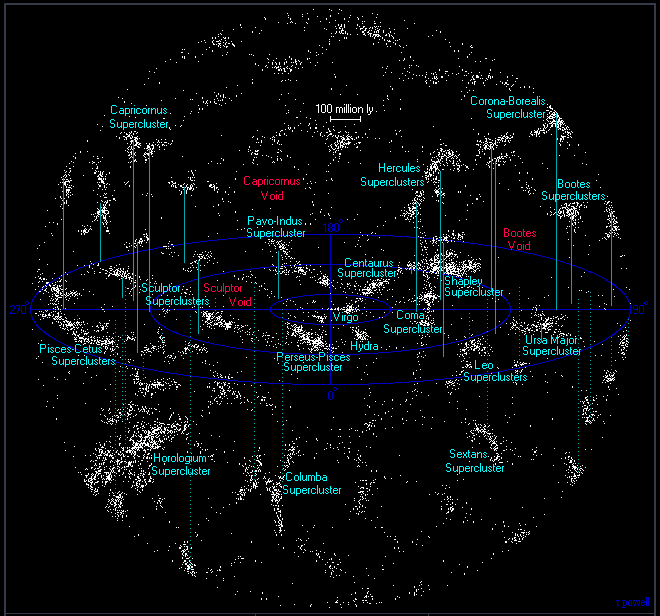An Ant's Everest Exploration
What shall we call ourselves?
“Man is the measure of all things.”
—Protagoras the Sophist—
—Protagoras the Sophist—
Are we truly the measure of all things, as he claimed?
Here, we have captured what can be seen between one meter above the ground and a space one billion light years away. Let us humbly reflect on the size of the “we” we speak of now, and on what the existence of “we” truly means.
Just as an ant takes a step to climb Mount Everest, let us too set off into the vast universe with the small power of science.
1 m
A space of size that humans can see, touch, and feel. A man lies asleep on a warm October day. Around him are the things that feed body and soul, and give joy. What he can see, touch, and feel…
10 m
His beloved wife is reading a magazine beside him, and the two of them are now at the very center of this unimaginable ascent into space.
100 m
Roads and a wharf come into view. To own even this much land would be considered success. Which city could this place be a part of?
1 km
We can now see Chicago’s Lake Shore Drive, Soldiers’ Field, and its museums.
10 km
The heart of Chicago at the edge of Lake Michigan. From this height, we can see the area in which about a million people live.
100 km
Chicago, where square roads intersect in orderly patterns. Someone might be looking up from the lakeshore and exclaiming how clear the sky is.
1,000 km
The grandeur of the great lake is revealed. Lake Michigan covers an area of 58,020 km² and is one of North America’s five Great Lakes. The others are Lake Superior (82,360 km²), Lake Huron (59,570 km²), Lake Erie (26,720 km²), and Lake Ontario (19,680 km²). Considering that the total area of Korea is about 221,000 km² (South: ~99,000 + North: ~122,000), we can grasp just how vast these lakes are.
10,000 km
Blue sky and massive clouds. Outlines of North and South America, the Pacific, and the Atlantic become visible. It took 300 years to make maps like this, and it was only in 1967—just 38 years ago—that we could see actual images of the continents.
100,000 km
The Earth, now small and frail-looking. The square that once held part of a man’s body now holds the entire Earth.
1,000,000 (1 M) km
The Earth is no longer distinguishable; instead, the Moon’s orbit becomes visible.
10⁷ (10 M) km
Earth, the Moon, and the Moon’s orbit all fit within this square. The green line marks Earth’s orbit.

10⁸ (100 M) km
Neither the Earth nor the Moon’s orbit is visible. Parts of the orbits of Venus, Earth, and Mars can be seen. Earth seems to exist in a space representing a 6-week period between September and October.
10⁹ (1 B) km
We can now see Sun and the orbits of Mercury, Venus, Earth, Mars, and part of Jupiter’s orbit. We are now 1 billion kilometers above Earth’s surface.
10¹⁰ (10 B) km
From here, most of the planetary orbits in the solar system are visible. Even the massive Sun appears faint. We are now rising beyond imagination—faster than the speed of light.
10¹¹ (100 B) km
We’ve left the solar system. Looking back from even farther than its full span. The recently discovered tenth planet (Hankyeoreh, August 1, 2005) is also here. Jupiter, Saturn—even the Sun itself—are indistinguishable without the aid of orbit lines and squares.
10¹² (1 T) km
The solar system is no longer distinguishable from the stars. We are in a sea of stars.
10¹³ (10 T) km = 1 Light-year
A unit unfamiliar in daily life.
9.46 trillion kilometers equals 1 light-year, but for convenience, let's assume 10 trillion kilometers as 1 light-year.
10¹⁴(100 T) km = 10 Light-years
We're not talking about something graceful or poetic here—just pure numbers. One hundred trillion kilometers, to be precise. That’s the kind of scale we’re dealing with. And so, we call it 10 light-years—the distance light travels in ten years.
*From here, we switch to light-years, as kilometers can no longer express such distances.
100 Light-years
If you flew for 100 years, where would you be? The answer: still within Earth’s skies. We cannot escape the atmosphere. But here, we are in a place reached after 100 years of travel at the speed of light—amid a sea of stars. Somewhere in that square is our mighty Sun. Without the Sun, we—and the Earth—would be a dead world. That is how great the Sun is.
1,000 Light-years
If we’re seeing these stars from Earth, we are seeing them as they were 1,000 years ago. Imagine it: some stars may no longer exist, and others may have been born.
10,000 Light-years
Rather than a sea of stars, it is now a cloud of stars. Twinkling cosmic gas. The spiral shape of a galaxy begins to emerge. We are beyond imagination.
100,000 Light-years
How long since mammals first appeared? There was no civilization ten thousand years ago, nor even one hundred thousand. The Milky Way, with over 100 billion stars. Our supposedly great Sun lies on the outskirts—so far we can’t even see it.
1,000,000 (1 M) Light-years
It’s not just the solar system that’s faint—the entire galaxy is now a blur. We dare not speak of distance.
10,000,000 (10 M) Light-years
A place reached only by traveling ten million years at the speed of light. Don’t you want to go? Touch those stars, galaxies, gas, and dust?
10⁸ (100 M) Light-years
Other clusters appear—like the Virgo Cluster. Our galaxy, the Milky Way, belongs to this vast cluster. It is our home—not just for humans, but for all life on Earth, all matter, the Moon, the planets of the solar system, countless stars, asteroids, gas, and dust. Here, “we” is a concept far grander than what humans normally use.
Even the clusters appear faint now. What words are needed? Within that tiny square is the man, the American continent, the Earth, the solar system, our galaxy, and even the other clusters.
From https://www.icc.dur.ac.uk/~tt/Lectures/Galaxies/LocalGroup/Back/superc.html
(Added in 2025): 10⁹ (1 B) Light-years
Thanks to advances in science, humanity has gained sharper cosmic vision. Here is the view of the universe as seen from within one billion light-years of Earth. But where is Earth in all of this?





























Comments
Post a Comment